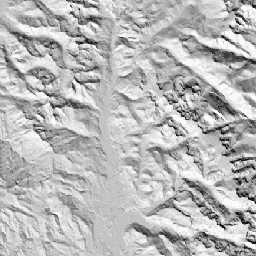
- Dostępność zbioru danych
- 2006-01-24T00:00:00Z–2011-05-13T00:00:00Z
- Dostawca zbioru danych
- Conservation Science Partners
- Tagi
Opis
CHILI to wskaźnik zastępczy dla wpływu nasłonecznienia i zacienienia topograficznego na ewapotranspirację. Jest on obliczany na podstawie nasłonecznienia wczesnym popołudniem, gdy wysokość słońca jest równa wysokości w okresie równonocy. Jest ona oparta na paśmie „AVE” o rozdzielczości 30 m z modelu ALOS DEM od JAXA (dostępnym w EE jako JAXA/ALOS/AW3D30_V1_1).
Zbiory danych Conservation Science Partners (CSP) Ecologically Relevant Geomorphology (ERGo), Landforms and Physiography zawierają szczegółowe dane wieloskalowe dotyczące form terenu i wzorców fizjograficznych (czyli aspektów terenu). Chociaż dane te można wykorzystać na wiele sposobów, ich pierwotnym celem było opracowanie istotnej z ekologicznego punktu widzenia klasyfikacji i mapy form terenu oraz klas fizjograficznych, które nadają się do planowania adaptacji do zmian klimatu. Przyszłe warunki klimatyczne są obarczone dużą niepewnością, a reakcje ekologiczne są jeszcze bardziej niepewne. Dlatego informacje o tym, co prawdopodobnie się nie zmieni, stanowią solidną podstawę do opracowywania przez menedżerów solidnych planów adaptacji do zmian klimatu. Kwantyfikacja tych cech krajobrazu jest wrażliwa na rozdzielczość, dlatego podajemy najwyższą możliwą rozdzielczość, biorąc pod uwagę zakres i charakterystykę danego indeksu.
Pasma
Rozmiar piksela
90 metrów
Pasma
| Nazwa | Minimum | Maks. | Rozmiar piksela | Opis |
|---|---|---|---|---|
constant |
0 | 255 | metry | Wskaźnik CHILI pochodzący z danych ALOS w zakresie od 0 (bardzo chłodny) do 255 (bardzo ciepły). Zostało ono przeskalowane z zakresu [0,1] w publikacji. |
Warunki korzystania z usługi
Warunki korzystania z usługi
Cytaty
Theobald, D. M., Harrison-Atlas, D., Monahan, W. B., & Albano, C. M. (2015). Mapy form terenu i różnorodności fizjograficznej istotne z ekologicznego punktu widzenia na potrzeby planowania adaptacji do zmian klimatu. PloS one, 10(12), e0143619
Odkrywanie za pomocą Earth Engine
Edytor kodu (JavaScript)
var dataset = ee.Image('CSP/ERGo/1_0/Global/ALOS_CHILI'); var alosChili = dataset.select('constant'); var alosChiliVis = { min: 0.0, max: 255.0, }; Map.setCenter(-105.8636, 40.3439, 11); Map.addLayer(alosChili, alosChiliVis, 'ALOS CHILI');
